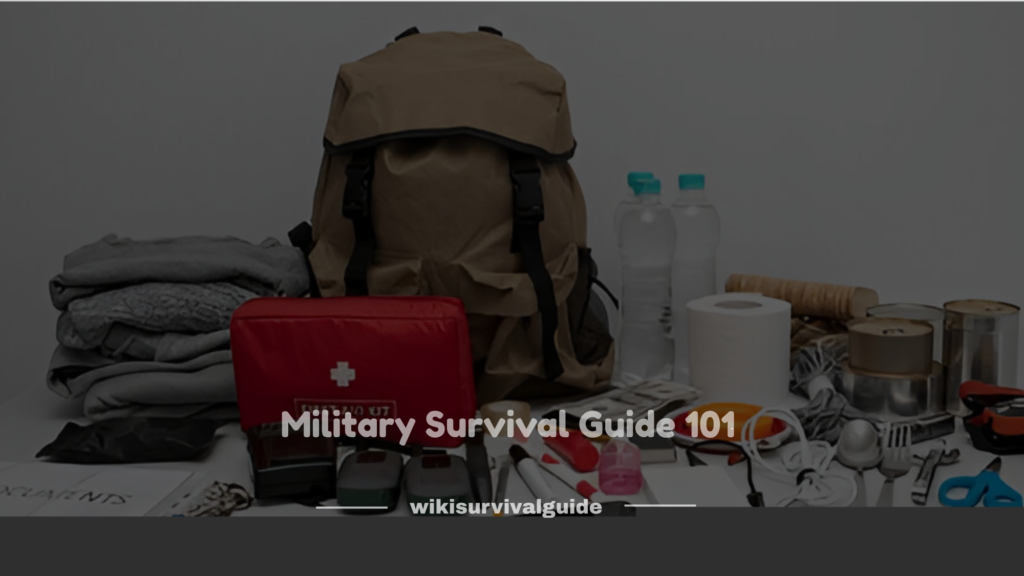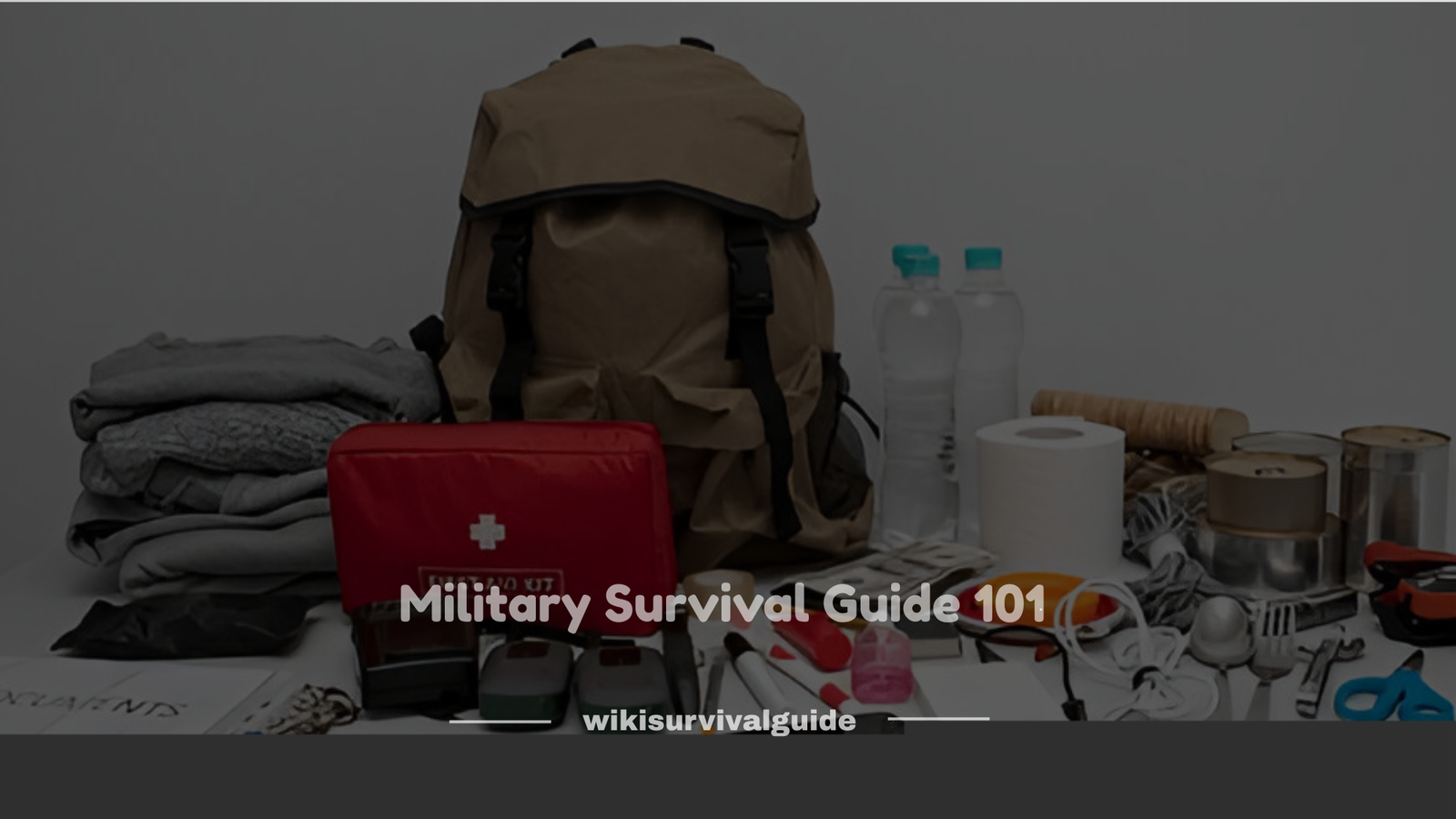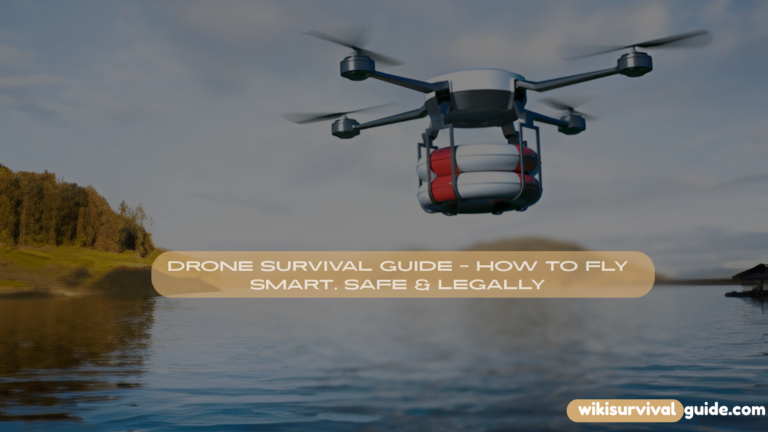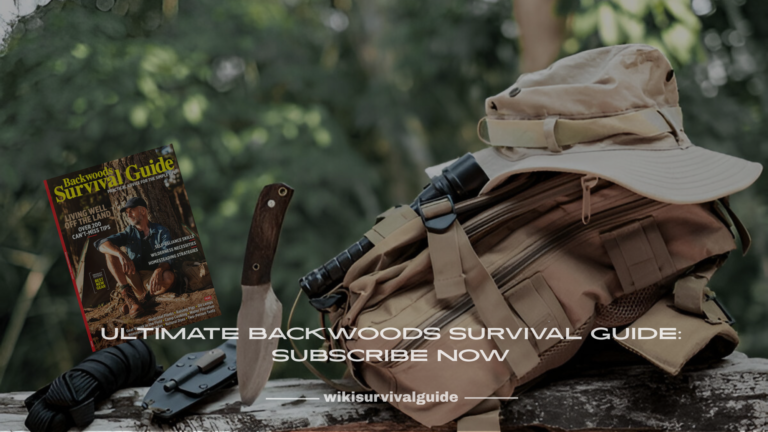When chaos hits, the military doesn’t panic—they adapt. That’s the magic of the military survival guide: it teaches you how to stay alive and in control when the world flips upside down. Think of it as life insurance with grit. Whether you’re hiking in the wild, stuck during a blackout, or navigating global crises, military tactics give you the upper hand. These skills aren’t just for soldiers—they’re for anyone who wants to be prepared, not panicked. Let’s dive into battle-tested strategies that can keep you safe, sharp, and standing strong.
Basic Survival Mindset and Situational Awareness
When it comes to survival, mindset is your most important tool. It’s not about brute strength or how much gear you’ve packed—those help, sure—but the real secret lies in mental toughness and clarity under pressure. In the military, soldiers are trained to adapt, improvise, and overcome. That kind of resilience is what keeps you alive when things go sideways.
Situational awareness is the cornerstone of that mindset. It’s about being alert to your surroundings, processing the environment in real time, and making fast, smart decisions. It’s more than just “paying attention.” It means noticing subtle shifts in weather, animal behavior, or people’s movements that could signal danger. In the wild, a broken branch could mean someone’s nearby. In the city, an unusual silence might mean something’s about to go down.
A good way to boost situational awareness is through habit. Train your mind to scan for exits every time you enter a building. Check your surroundings before sitting down at a restaurant. Keep your head on a swivel when walking in unfamiliar places. These tiny routines become second nature and could save your life when a crisis hits.
Mental conditioning also helps. Meditation, breath control, and visualization exercises used by elite soldiers can train your brain to remain calm under stress. When your heart rate rises and adrenaline kicks in, you’ll stay cool, think clearly, and respond instead of react.
Ultimately, survival is more mental than physical. Develop a tough mind, train it to observe without panic, and you’ll gain a serious edge in any situation.
Understanding the OODA Loop: Observe, Orient, Decide, Act
The OODA Loop is a decision-making framework created by U.S. Air Force Colonel John Boyd, and it’s been adopted across military and survival training because it works under extreme stress. OODA stands for Observe, Orient, Decide, and Act. It’s a cycle that lets you outmaneuver threats, even in chaotic environments.
Step one, observe, is all about gathering information. You take in everything—your surroundings, your own condition, and any potential dangers. This might mean listening for distant noises, spotting movement in your peripheral vision, or noting changes in weather patterns.
Next is orient. This is where your past experiences, training, and even instincts come into play. You interpret what you’ve observed in the context of your situation. Is that sound a threat or just wind in the trees? Orientation is also where bias can mess you up—if you misinterpret the situation, your next move could be wrong. Training helps refine this step.
Then comes decide. Based on what you’ve observed and how you’ve interpreted it, you choose a course of action. Do you retreat? Engage? Move to higher ground? You need to make that choice quickly, because survival situations don’t give you time to think forever.
Finally, you act. You execute the decision with focus and commitment. The faster you move through this loop—and the more accurate each step is—the more likely you are to gain the upper hand, especially in a conflict or disaster.
What’s powerful about the OODA Loop is that it’s repeatable and adaptable. Once you’ve acted, you immediately begin observing again. That constant cycle gives you an edge, keeps you flexible, and helps you survive when it counts most.
Tactical Gear Every Civilian Should Own
When it comes to being prepared, having the right gear can mean the difference between a minor inconvenience and a full-blown survival emergency. You don’t need to build an arsenal, but having a well-thought-out collection of tactical gear is a must for any civilian serious about self-reliance.
Start with the basics: a solid knife, a multitool, a water purification system, and a reliable flashlight. These four tools alone can handle everything from building shelter to signaling for help. Your knife should be full-tang and fixed blade—think durability, not just looks. A quality multitool gives you screwdrivers, pliers, wire cutters, and more in one compact setup.
Next up: protection and concealment. A tactical backpack made of tough, waterproof material with multiple compartments makes organizing gear easy. Add a compact rain poncho, camouflage netting, and thermal blankets. You never know what environment you’ll face, and layering up can keep you alive.
Communication tools are also important. A hand-crank emergency radio and a fully charged power bank can help you stay informed or call for help. Pair that with a small mirror and a whistle for low-tech signaling options.
Don’t forget personal defense. Pepper spray, a tactical pen, or even a legal folding knife gives you an edge in tight situations. You don’t need to go full commando, but a few solid tools on hand can keep you safe.
Finally, pack everything in a bug-out bag that’s light enough to carry but durable enough for any conditions. Tactical gear is about efficiency, reliability, and purpose—don’t overpack, but make sure what you carry earns its weight.
How to Build and Pack a Military-Grade Bug-Out Bag
A military-grade bug-out bag isn’t just a backpack full of stuff—it’s a lifeline. Designed to sustain you for 72 hours, your bug-out bag should be organized, durable, and tailored to your environment. Every item should have a job, and nothing should be in there just because it “might” be useful.
Start with the bag itself. Choose one made from water-resistant materials with MOLLE webbing, multiple compartments, and comfortable shoulder straps. You’ll be carrying it under stress, so comfort matters. Internal organization is key—group similar items together using dry bags or pouches.
Now for the essentials. First, water. You’ll need at least one liter per day, plus a water filter or purification tablets. Pack high-calorie food bars or MREs that require little to no prep. Shelter is next: a compact tarp, paracord, and an emergency blanket can build a quick cover.
Add fire-starting tools like waterproof matches, a ferro rod, and dryer lint or cotton balls soaked in petroleum jelly. Lighting is crucial, so include a headlamp and extra batteries. For navigation, throw in a compass and map of your area. GPS is great—until your battery dies.
Your bug-out bag should also include a first-aid kit with trauma supplies, not just band-aids. Add gloves, antiseptics, tourniquet, and painkillers. A multi-tool, duct tape, notepad, pencil, and hygiene items like biodegradable wipes round out the kit.
Don’t forget ID copies, cash, and any medications. Keep everything light, but comprehensive. Review and repack your bag every six months to ensure everything is fresh, working, and relevant.
A well-packed bug-out bag isn’t just gear—it’s peace of mind in a crisis.
Land Navigation Without GPS: Using Maps and Compass
In today’s world, we rely on GPS for everything. But what if the satellites go down, your phone battery dies, or you’re deep in the wilderness with no signal? That’s when good old-fashioned land navigation saves the day—and possibly your life.
Start by learning to read a topographic map. These maps show elevation, terrain features, and man-made structures. Understanding contour lines, scale, and symbols is key to interpreting your surroundings and making smart decisions about where to go and what to avoid.
Next, get to know your compass. A military-style lensatic compass is durable and precise. Learn to shoot an azimuth—this means taking a bearing and following a straight path toward a specific direction. Always account for declination, which is the difference between magnetic north and true north. That small adjustment can make a big difference over long distances.
Combine your map and compass by plotting your current location and identifying landmarks around you. Use triangulation—taking bearings from two or more known points to pinpoint your position. It’s a simple but effective method used by military personnel around the globe.
Pace counting is another handy trick. By knowing how many steps you take per 100 meters, you can estimate distance traveled even without a GPS. Tie beads (ranger beads) onto paracord to help track distance as you move.
Practice these skills in your local park or wilderness area. Don’t wait for an emergency to try and figure it out. Mastering land navigation puts you in control, not just wandering. It’s quiet, reliable, and immune to dead batteries—which is more than we can say for your smartphone.
Shelter-Building Skills in Any Environment
When you’re exposed to the elements, your survival clock starts ticking fast. In cold, wet, or scorching hot environments, building a shelter isn’t optional—it’s essential. Military training emphasizes the “Rule of Threes”: you can survive 3 hours without shelter in harsh conditions. That’s how crucial it is.
Start by assessing your surroundings. Are you in the forest, desert, mountains, or urban ruins? The environment determines your materials. In the woods, fallen branches, leaves, and moss become your toolkit. In a desert, you might use rock overhangs or dig into the sand for cooler ground.
The simplest and fastest military-style shelter is a lean-to. Just prop a sturdy branch between two trees and lean smaller branches against it to create a wall. Add insulation with leaves or a tarp if you have one. Tarps, by the way, are shelter gold—lightweight, waterproof, and versatile.
If you’re in snowy terrain, dig a snow trench or build a quinzhee (a snow dome). In the jungle, elevation matters—stay off the ground to avoid insects, snakes, and moisture.
Ventilation is key. Always leave space for airflow to prevent condensation or carbon monoxide if you’re building a fire inside. Also, position your shelter away from dead trees or areas prone to flooding.
Practice makes perfect. The first time you build a shelter shouldn’t be when you’re freezing in the woods. Try it on a weekend hike, test your skills, and figure out what works best. Shelter is your first line of defense against nature—and knowing how to throw one together on the fly could be what keeps you alive.
Water Purification Methods Used by the Military
Water is life—plain and simple. You can last for weeks without food, but only about three days without water. That’s why military survival training puts such a heavy focus on finding and purifying water in any environment. Clean water isn’t always available, but safe water can be made almost anywhere with the right know-how.
The first step is locating water. Look for signs like animal tracks, lush vegetation, or even condensation on metal or plants. Once you’ve found a source, you have to assume it’s contaminated. Even the clearest stream can carry bacteria, parasites, or harmful chemicals.
The military uses several key purification methods. One of the most reliable is boiling. Bring water to a rolling boil for at least one minute (three minutes at higher altitudes). This kills bacteria, viruses, and most parasites.
Portable filtration systems are another go-to. Compact filters like those used in Lifestraw or pump-style purifiers remove bacteria and protozoa effectively. Some even handle viruses with an added chemical treatment.
Speaking of chemicals, purification tablets or drops (like iodine or chlorine dioxide) are compact, light, and perfect for bug-out bags. Just add the right amount, wait about 30 minutes, and you’re good to go.
UV purification pens are high-tech but effective. They use ultraviolet light to neutralize pathogens in minutes—though they depend on batteries, so keep spares.
When you’re stuck, even DIY options like improvised charcoal-sand filters can help remove debris and improve taste. But remember: filtration doesn’t equal purification. Always follow up with boiling or chemical treatment.
Clean water isn’t a luxury—it’s your lifeline. Know how to make it safe, and you’re miles ahead in any survival scenario.
Fire Starting Techniques Under Stress and in Bad Weather
Fire isn’t just about warmth. It’s comfort, cooking, sterilization, signaling, and morale—all in one. In military survival training, fire starting is a top skill, especially in miserable weather when it’s hardest to do. And let’s be real—when you’re cold, wet, and stressed out, starting a fire can feel impossible unless you’ve trained for it.
First, always carry at least three ways to start fire. A lighter is great, but unreliable when wet or out of fuel. Waterproof matches are a solid backup, and a ferrocerium rod (a ferro rod) is the go-to for long-term use. It throws sparks at over 3,000°F—more than enough to light dry tinder.
Speaking of tinder, always pack some. Cotton balls soaked in petroleum jelly, dryer lint, or even a tampon fluffed up can catch a spark easily. Keep them in a waterproof bag or pill bottle. In the wild, look for dry bark, pine needles, or fatwood—wood infused with natural resin that lights fast even when damp.
Create a fire lay that suits your situation. The teepee structure is great for fast ignition; the log cabin design offers longer burn time. In rainy conditions, build a platform of dry wood or bark to keep the fire off wet ground. Shield it from wind with rocks or your body while lighting.
Train under pressure. Try starting a fire with cold fingers or while it’s drizzling. The goal is muscle memory. When your life depends on it, you’ll be glad you practiced.
Bottom line: fire is survival. Pack smart, practice often, and don’t wait for a disaster to learn what works.

Military Food Rations and Long-Term Nutrition Planning
When it comes to survival, food isn’t your first priority—but it becomes one quickly once you’re past the 72-hour mark. Military rations are designed to provide high-calorie, nutrient-dense meals in compact, portable formats. Knowing how to ration food and plan nutrition can keep your body going and your mind sharp in long-term situations.
Let’s start with MREs—Meals Ready to Eat. These are the gold standard for military rations. Each one packs about 1,200 calories and includes everything you need: entree, sides, snacks, drink mix, even a flameless heater. They’re shelf-stable for years and designed to keep you fueled under harsh conditions.
For civilians, you can either buy surplus MREs or create your own version. Look for foods that are high in calories, require no refrigeration, and have a long shelf life. Think peanut butter, jerky, trail mix, canned meats, and protein bars.
A key military trick is to eat for performance. Don’t just fill your stomach—fuel your energy. Include a balance of carbs, protein, and fat. Carbs give you fast energy, fats help with long-term fuel, and protein keeps your muscles from breaking down.
Long-term planning also means knowing how to stretch your supplies. Rationing is an art. Eat small meals throughout the day to keep energy up without burning through your stash. Military survivalists also learn to forage and fish to supplement their diet when rations run low.
And hydration matters just as much. Some MREs contain salty foods to encourage drinking more water. Always balance food intake with your water supply.
Food keeps you going, but smart food planning keeps you alive. Stock up, pack smart, and don’t underestimate the power of a good meal in a bad situation.
Camouflage and Concealment for Civilians
In a survival scenario, sometimes the smartest move isn’t fighting or fleeing—it’s hiding. Camouflage and concealment are core parts of military survival strategy, and civilians can benefit just as much from learning how to stay out of sight when things get dangerous.
Camouflage is about blending in with your environment. That doesn’t mean wearing camo pants 24/7—it means choosing clothing and gear that matches your surroundings. Earth tones like greens, browns, and grays work well in most outdoor settings. In an urban environment, darker, muted colors blend better than flashy gear.
Cover your shiny gear—metal buckles, tools, or screens can reflect light and give you away. Use tape, paint, or mud to dull the shine. Break up your outline, too. Human shapes are easy to spot, especially from a distance. Adding branches, leaves, or even just adjusting your posture can help disguise your form.
Concealment is about positioning. Stay in the shadows, use natural cover like bushes or fallen logs, and avoid skylining—walking along ridges or high points that make you stand out against the sky. At night, light and sound discipline is key. Keep flashlights covered, muffle your steps, and avoid talking loudly.
For urban scenarios, blend in with the crowd. Don’t dress like you’re prepping for war—dress like everyone else. Stay neutral and invisible.
The goal is to avoid confrontation, not invite it. Knowing when and how to disappear is one of the most powerful tools in your survival toolkit. Invisibility isn’t just for ninjas—it’s for anyone who wants to live to see another day.
Basic Military First Aid and Trauma Management
In a crisis, seconds count. Knowing how to handle injuries before professional help arrives can be the difference between life and death. Military personnel are trained to manage trauma in the field, and civilians can learn those same life-saving techniques with just a little effort.
Start with the basics: CPR, wound care, and the Heimlich maneuver. These are standard, but critical. Then move into more advanced skills like applying a tourniquet, packing a wound, and treating shock—core techniques in military trauma kits.
Every first aid kit should include gauze, pressure bandages, antiseptics, gloves, scissors, and a tourniquet. The military uses items like the CAT (Combat Application Tourniquet), which is fast and effective for stopping life-threatening bleeding. Learn how to use one properly—tighten until bleeding stops, not just until it’s snug.
For deeper wounds, hemostatic agents like QuikClot can stop bleeding fast by promoting clotting. These are game-changers, especially if help is hours away.
Treating for shock is equally important. If someone is pale, clammy, and confused, lay them down, elevate their legs, and keep them warm. Reassurance goes a long way too—calm words can stabilize a panicking person faster than you think.
Learn how to assess the ABCs: airway, breathing, and circulation. Check for blockages, listen for breathing, and look for major bleeding. Prioritize accordingly.
Finally, take a basic trauma course or a Stop the Bleed class. These give you hands-on training, which is far more effective than just reading about it.
You don’t have to be a medic to save a life—you just have to be prepared.
Escape and Evasion Techniques in Hostile Situations
In a survival situation, your ability to escape and evade capture could determine whether you make it out alive. Military training prioritizes avoiding detection, staying off enemy radar, and creating opportunities to escape once you’re trapped. Civilians can also adopt these tactics in hostile situations.
Escape starts with mental preparation. Always have an exit strategy. If you’re in a risky environment, look for possible escape routes. High ground offers a great vantage point to spot potential threats. Always know the area’s geography and potential hiding spots before you need them.
Evasion is about staying invisible. Move quietly, stick to natural cover, and avoid leaving a trail. If you’re in the wild, walking in water or through mud can mask your footprints. In urban areas, take advantage of alleyways, dark corners, and crowded areas to blend in and slip away.
A key military trick for evading detection is “breaking contact.” If you’re pursued, use decoys or distractions like creating noise in one area while you move quietly in another. Use your environment—shadows, terrain features, and weather conditions—to cover your movements.
Remember, evasion is not about confrontation. Your goal is to survive, not to fight. Escape is about patience, awareness, and quick decision-making.
In the end, it’s all about mindset. Train yourself to think like an evader, not a fighter. Whether it’s breaking free from hostile forces or escaping a dangerous encounter, these techniques can make the difference between safety and disaster.
Self-Defense and Combat Survival Basics
Self-defense is a critical skill in any survival situation, especially when faced with a direct threat. While the military focuses on combat tactics, civilians can apply many of these principles to enhance their safety in dangerous situations.
The first line of defense is awareness. Always be alert to your surroundings and trust your instincts. If something doesn’t feel right, take action immediately. Awareness is often the best weapon against danger, allowing you to avoid confrontations before they escalate.
Physical self-defense skills are also essential. The military trains soldiers in hand-to-hand combat, and civilians can benefit from learning basic moves like strikes, blocks, and escape techniques. Martial arts like Krav Maga or Brazilian Jiu-Jitsu focus on practical self-defense, teaching you to incapacitate an attacker quickly and efficiently.
In addition to physical skills, weapons can provide an added layer of protection. Depending on your legal rights and training, carrying a concealed weapon or knife might be appropriate. Learn how to handle and store weapons safely. Military personnel are trained in using weapons for both defense and offense, but for civilians, the goal is to neutralize the threat, not escalate the conflict.
Lastly, combat survival basics include mental toughness. In the heat of battle, keeping calm and focused can be the deciding factor. Train yourself to control panic and make rational decisions under pressure.
Self-defense is about protecting yourself, and with the right mindset and training, you can survive even the most dangerous situations.
Military Communication Methods: Hand Signals and Radio Protocol
In survival situations, especially those involving multiple people, communication is key. Military communication methods, including hand signals and radio protocols, are essential tools for maintaining coordination while avoiding detection. While you may not have access to military radios, understanding these principles can make your survival efforts much more effective.
Hand signals are the go-to method in situations where verbal communication could give you away. They’re silent, quick, and universally understood in most military settings. Basic signals include “halt,” “advance,” and “move to cover.” Learn these fundamental signals and practice them with others so you can communicate in stealthy situations.
Radio communication is another critical aspect of military operations. If you have access to a two-way radio, understanding basic radio etiquette can ensure smooth communication. Military personnel use specific protocols like calling “over” when finished speaking and waiting for acknowledgment before responding.
When using radios in a survival scenario, prioritize short, clear messages. The fewer words, the better. Avoid unnecessary chatter, and always verify that the message was received. You’ll also want to make sure your radio frequencies are secure, as you don’t want your messages intercepted by unwanted parties.
If you don’t have access to radios, you can still create an effective communication system using signs, pre-arranged signals, or even physical cues like flashes of light or sounds.
In any situation, whether you’re part of a team or alone, maintaining effective communication can make or break your survival efforts.
How to Handle Psychological Stress in Survival Scenarios
Surviving in extreme conditions isn’t just about food, water, and shelter—it’s about mental resilience. Psychological stress is one of the most dangerous aspects of survival situations, and military personnel are trained to manage it effectively. Civilians can also benefit from understanding how stress affects their mind and body, and how to cope with it.
In high-stress situations, your mind can quickly spiral into panic. That’s where mental training comes in. Military survivalists are taught techniques like controlling breathing, positive visualization, and focusing on tasks rather than emotions. These methods can help you regain control of your mind and keep yourself calm.
One key technique is breaking the situation into manageable chunks. Don’t focus on the overwhelming task ahead. Instead, focus on small, achievable steps, like building shelter, finding water, or making fire. This keeps your mind engaged and helps prevent feelings of helplessness.
Maintaining a survival mindset is also important. This mindset encourages optimism, adaptability, and a focus on what you can control. Remind yourself regularly of your goals and why you’re in the situation: survival. Staying goal-oriented will help prevent despair from taking root.
Finally, don’t underestimate the power of emotional support. If you’re not alone, lean on your fellow survivors. The shared experience can create a bond that strengthens your mental fortitude.
Psychological resilience is as important as physical survival skills. By training your mind, you’ll be better prepared for any mental battle that comes your way.
Silent Movement and Stealth in Tactical Environments
In survival situations, sometimes the best option is to avoid confrontation entirely. Silent movement and stealth are crucial skills in military tactics, and they can be just as effective for civilians trying to stay safe in dangerous situations.
The first rule of silent movement is slow and deliberate action. Avoid sudden movements or jerky motions that can create noise or alert someone to your presence. Keep your body low to the ground, and use natural cover to hide your silhouette. In dense woods, move quietly through vegetation, stepping over branches instead of on them.
Your shoes matter. Military personnel use soft-soled boots that don’t make noise on various terrains. As a civilian, you can use boots with quiet tread, or even practice moving in socks or bare feet in areas where noise is crucial to avoid.
In tactical environments, shadows are your friend. Move along the edges of light and darkness, always keeping in mind that bright areas can expose you. Nighttime is the ultimate advantage for silent movement—use darkness to your benefit, and always have a plan for lighting, should you need it.
Don’t forget to control your breath. Loud exhalations or rapid breathing can give you away in a still environment. Practice slow breathing to stay calm and avoid making noise when stressed.
Stealth is about blending into your surroundings, remaining unseen, and moving without leaving a trace. In a hostile environment, disappearing is your best defense.
Weapon Safety and Improvised Defense Tools
Whether you’re a civilian with a firearm or facing a dangerous situation without a weapon, weapon safety and improvised defense tools are vital to your survival. In military training, weapon handling is a discipline that could save your life in combat or survival situations.
Weapon safety starts with the basics: always treat a weapon as if it’s loaded, even if you think it’s not. Always point it in a safe direction and keep your finger off the trigger until you’re ready to shoot. Regularly clean and maintain your weapons, whether it’s a firearm, knife, or other tool. Ensuring everything is in working order when you need it can be the difference between life and death.
If you’re without a traditional weapon, you can rely on improvised tools. A sturdy stick can be turned into a spear, a rock can become a thrown weapon, and kitchen knives or sharp objects can serve as makeshift weapons. The military teaches improvisation—being creative with what’s available around you. A belt can be used to bind wounds, a jacket to create a sling, and even a fire extinguisher can be used to disorient attackers in close quarters.
Improvised defense tools are about using your surroundings to your advantage. Stay resourceful, and remember that a sharp mind can be just as powerful as a sharp weapon.
Conclusion
The military survival guide bridges the gap between survival theory and actionable life-saving tactics. Whether you’re planning a hike, preparing for natural disasters, or simply want peace of mind, these skills make you stronger, smarter, and safer. You don’t have to be in uniform to think like a warrior. Prep smart, train hard, and remember: survival favors the mentally ready and practically trained.
FAQs
Q1: Can civilians train using military survival techniques?
Absolutely! Many survival schools and online resources teach the same skills soldiers use in the field.
Q2: What is the best survival knife for a beginner?
Look for a fixed-blade knife with a full tang. Brands like KA-BAR or Gerber are solid choices.
Q3: How much does a military-style bug-out bag weigh?
Ideally, 20–30 pounds for mobility. Pack light, pack smart.
Q4: Are military survival kits available for purchase?
Yes, but DIY kits are often better because they’re tailored to your environment and needs.
Q5: What’s the #1 mistake people make in survival situations?
Panic. Staying calm and sticking to what you know can be the difference between life and death.




Leave a Comment